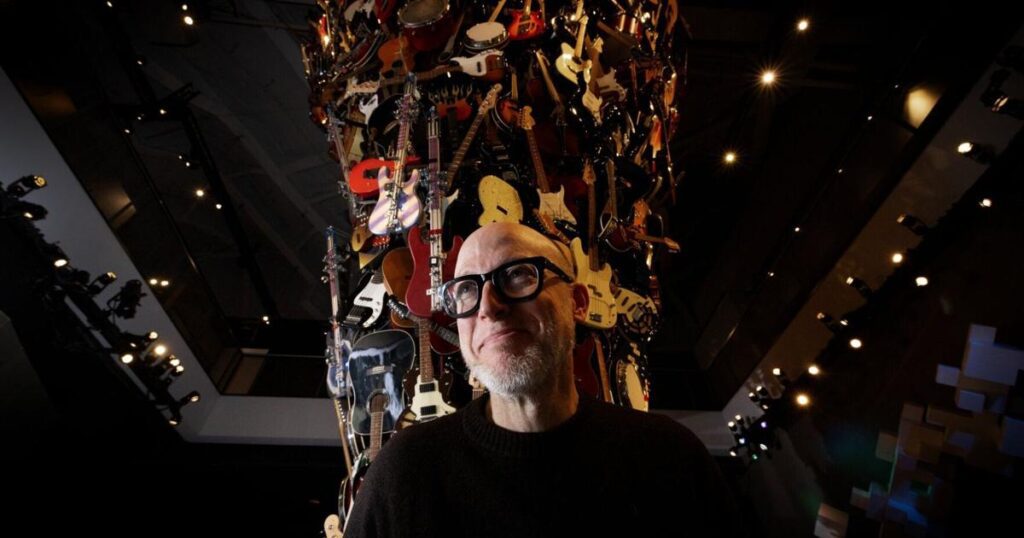It sounds like something out of a James Bond or Indiana Jones movie.
Over its 25 years of existence, Seattle’s Museum of Pop Culture — MoPOP as it’s been known the last decade — has amassed more than 80,000 artifacts of music and pop culture memorabilia. Everything from infamous Jimi Hendrix guitars to George Clooney’s “Batman” suit.
Despite its expansive Seattle Center digs — paid for by the museum’s tech mogul founder, Paul Allen — MoPOP’s Frank Gehry-designed home can only display less than 1% of MoPOP’s collection at any given time. As for the rest of it?
“We have a secret underground vault with an actual moat,” said Jacob McMurray, MoPOP’s chief collections and exhibitions officer. “It doesn’t have water or alligators. But it is a dry moat, which is essentially a fire barrier, and it’s in an undisclosed location.”
McMurray has been with MoPOP since the beginning. Even before the beginning, really, starting as a 22-year-old curatorial assistant in 1994, six years before the museum first opened as the Experience Music Project in 2000. Over the subsequent decades, MoPOP has evolved from Allen’s initial vision as a hometown Hendrix shrine to an interactive music-and-more temple of “nerdy passion and popular culture,” as McMurray puts it.
Since Allen’s death in 2018, MoPOP and its polarizing architecture (inspired by smashed guitar fragments) has stood as a physical manifestation of the Microsoft founder and music buff’s Seattle arts legacy, one that’s poised to adapt to the ever-shifting landscape of pop culture — with McMurray integral to the 25-year-old museum’s future.
But first, MoPOP celebrates its silver anniversary with an Oct. 23 Icons of Pop Culture Gala and concert saluting leading figures in film, fashion, music, gaming and more. A musical performance paying tribute to MoPOP’s original muse, Hendrix, features a murderers’ row of guitarists, including Pearl Jam’s Mike McCready, Kenny Wayne Shepherd, Christone “Kingfish” Ingram, Devon Allman, Robert Randolph, Dweezil Zappa, rising blues rock star Samantha Fish, Seattle shredder Ayron Jones and more.
Throughout the years, McMurray’s role has evolved. Besides overseeing the “vault,” which only a handful of people have access to, McMurray leads a 20-person team that manages all of MoPOP’s exhibitions — from the recently wrapped Nirvana exhibit to the Science Fiction and Fantasy Hall of Fame — while “preserving and elevating the permanent collection,” he said. That team includes a number of curators, designers and fabricators, including their own wood and metal shop to construct all the cases and built-in display elements. In the museum world, it’s somewhat of a rarity to have all those capabilities in-house, McMurray said.
“Anything that we can imagine, if we have enough time and budget, we can do it,” he said.
It’s a far cry from the early days when McMurray’s old boss, Jim Fricke, only got the green light to hire him if they promised to share a desk and computer.
McMurray signed on during the summer of ’94, just a few months after Kurt Cobain died, a seismic event in music history felt even more acutely here in Seattle. A young assistant at the time, McMurray wasn’t privy to high-level strategic conversations, but from what he remembers, it became evident that the museum should expand its initial vision as a Hendrix homage and “also pay attention to all this amazing music that is happening in the Pacific Northwest right on our doorstep.”
“The idea was let’s make a new type of museum — a museum that celebrates the things you don’t often see in museums at all,” McMurray said. “That idea of music and culture that is being created by the masses. I feel like today, that isn’t such a radical idea. … but at the time, that idea felt pretty radical.”
However radical at the time, there weren’t many museums scouring for grunge or hip-hop memorabilia, enabling McMurray and the early EMP crew to hunt for (and be able to afford) pieces linked to both Seattle’s alt-rock revolution of the ’80s and ’90s and hip-hop’s birth in New York City. (According to McMurray, MoPOP has one of the “biggest hip-hop collections in the world,” some of which should be culled from the vault for the upcoming “Beats + Rhymes: A Collective Narrative of Hip-Hop,” opening in November.) Nowadays, MoPOP likely wouldn’t be able to afford something like a Cobain guitar, which McMurray said would likely fetch north of $500,000 at auction.
Part of the challenges for any museum — especially one focused on pop culture — is continuing to grow and keep up with the times, McMurray said. Part of the calculus he and his team uses for determining how to spend MoPOP’s “modest” budget for adding to that 80,000-piece collection is trying to identify which figures and creative movements are more than just “a flash in the pan.”
In the last several years, that’s meant embracing “the idea that pop culture is global, that it’s not Amerocentric,” McMurray said. “It is really an ongoing dialogue across the globe.” That philosophy, which ought to help MoPOP’s quest for continued relevance over the next 25 years, is part of what led the museum to recently acquire a piece linked to K-pop star Lisa of Blackpink.
“Being a museum of pop culture, that is one of our biggest challenges,” McMurray said. “We are not a museum that is always looking backward.”


